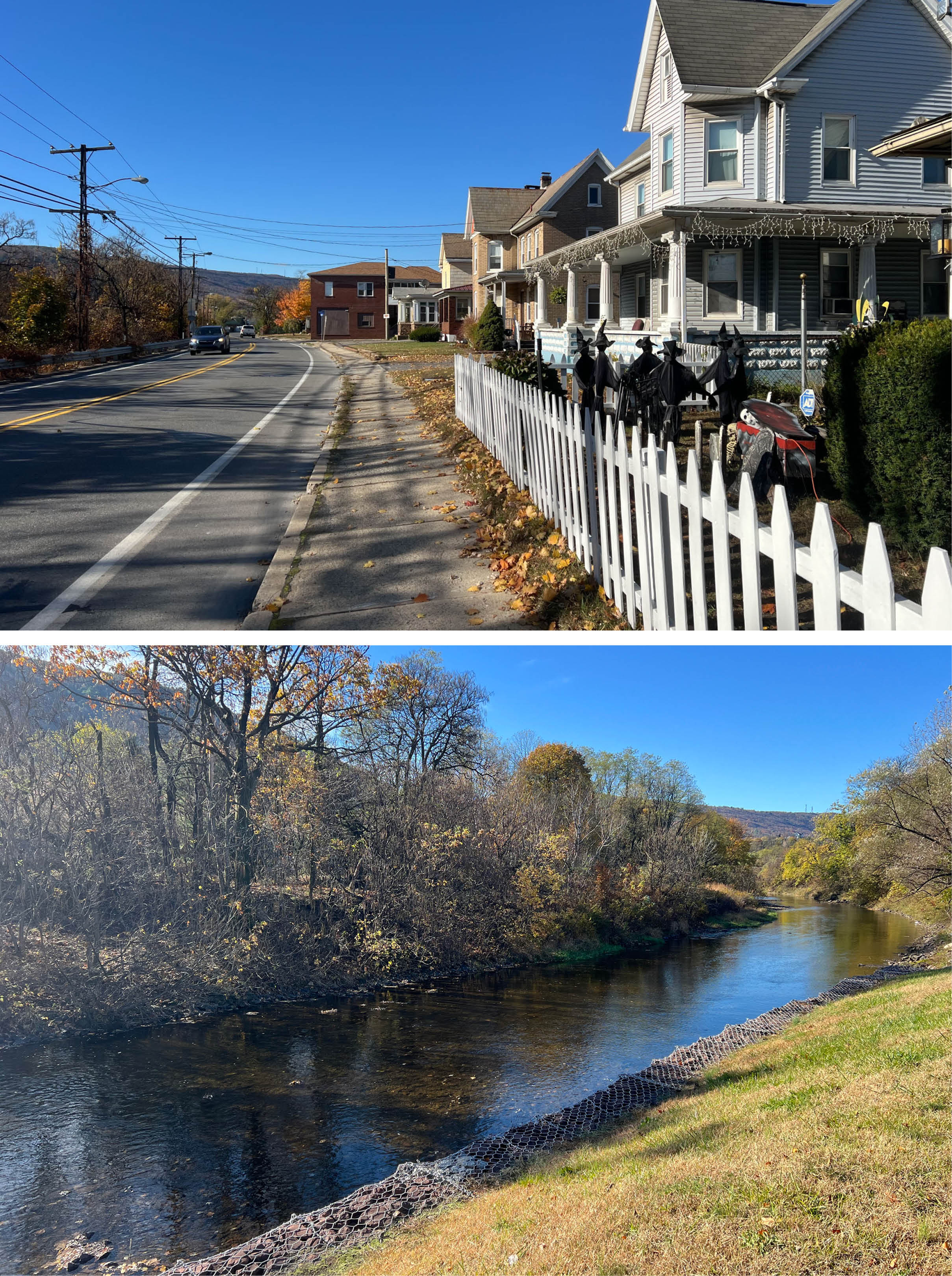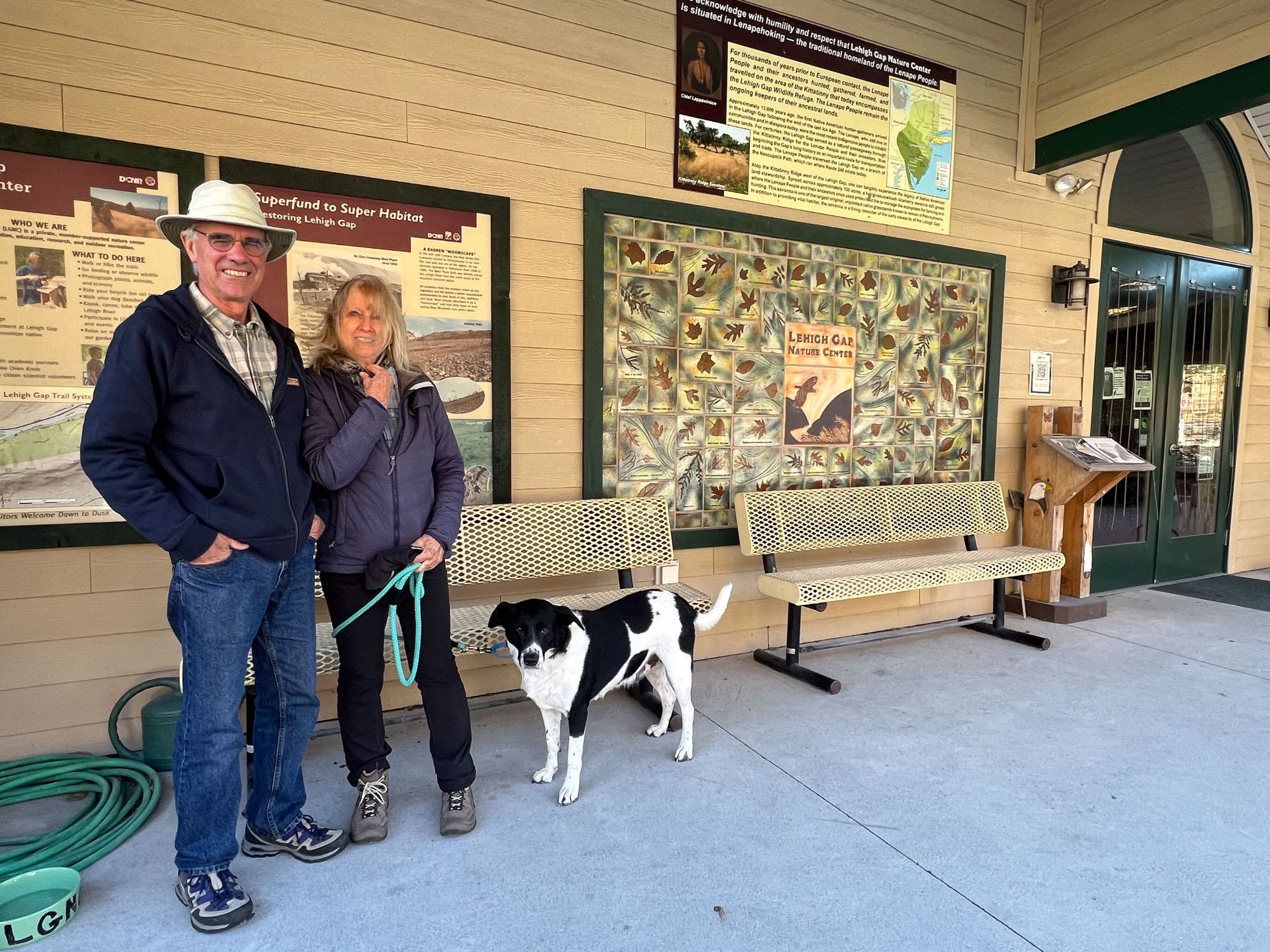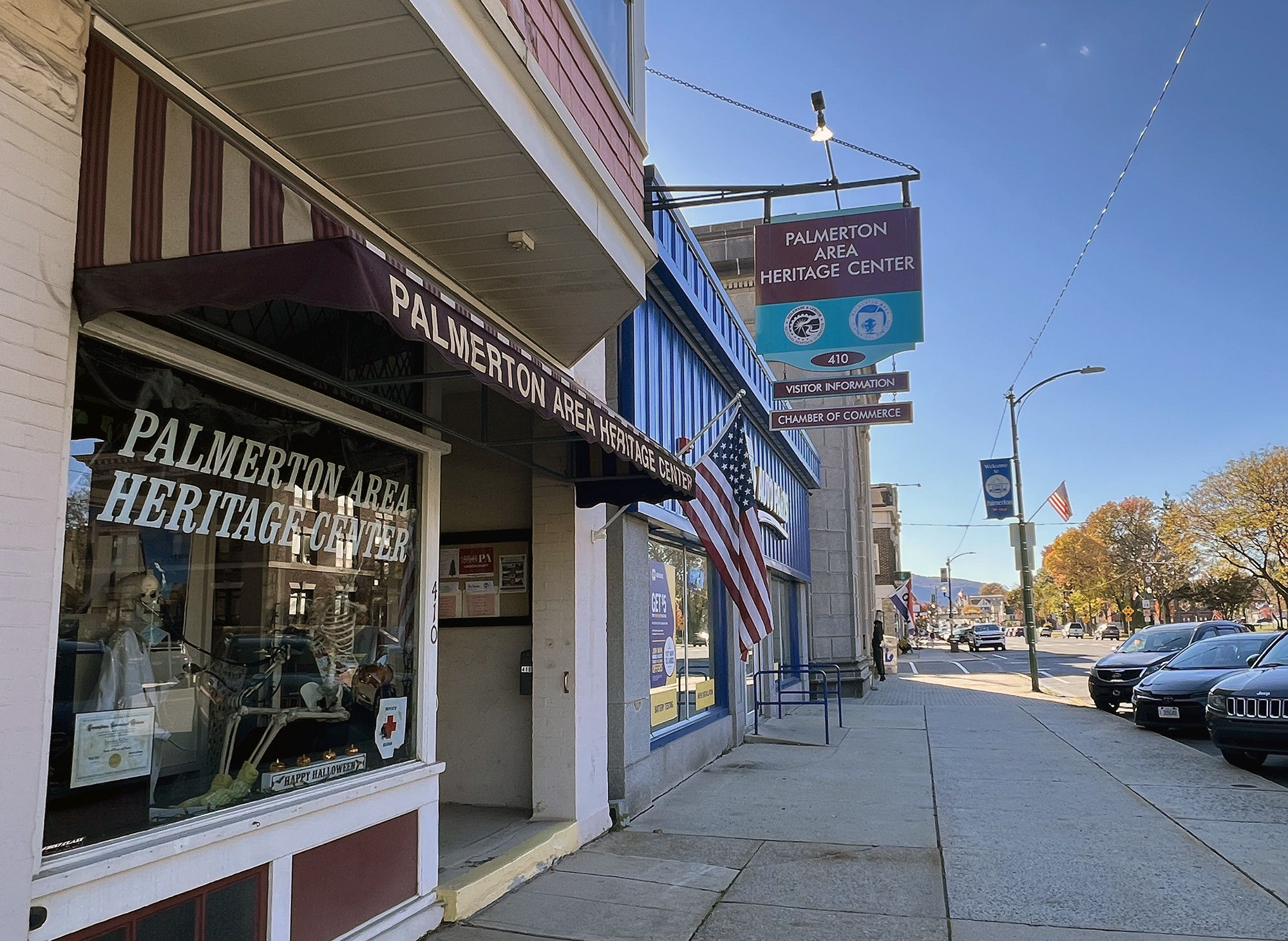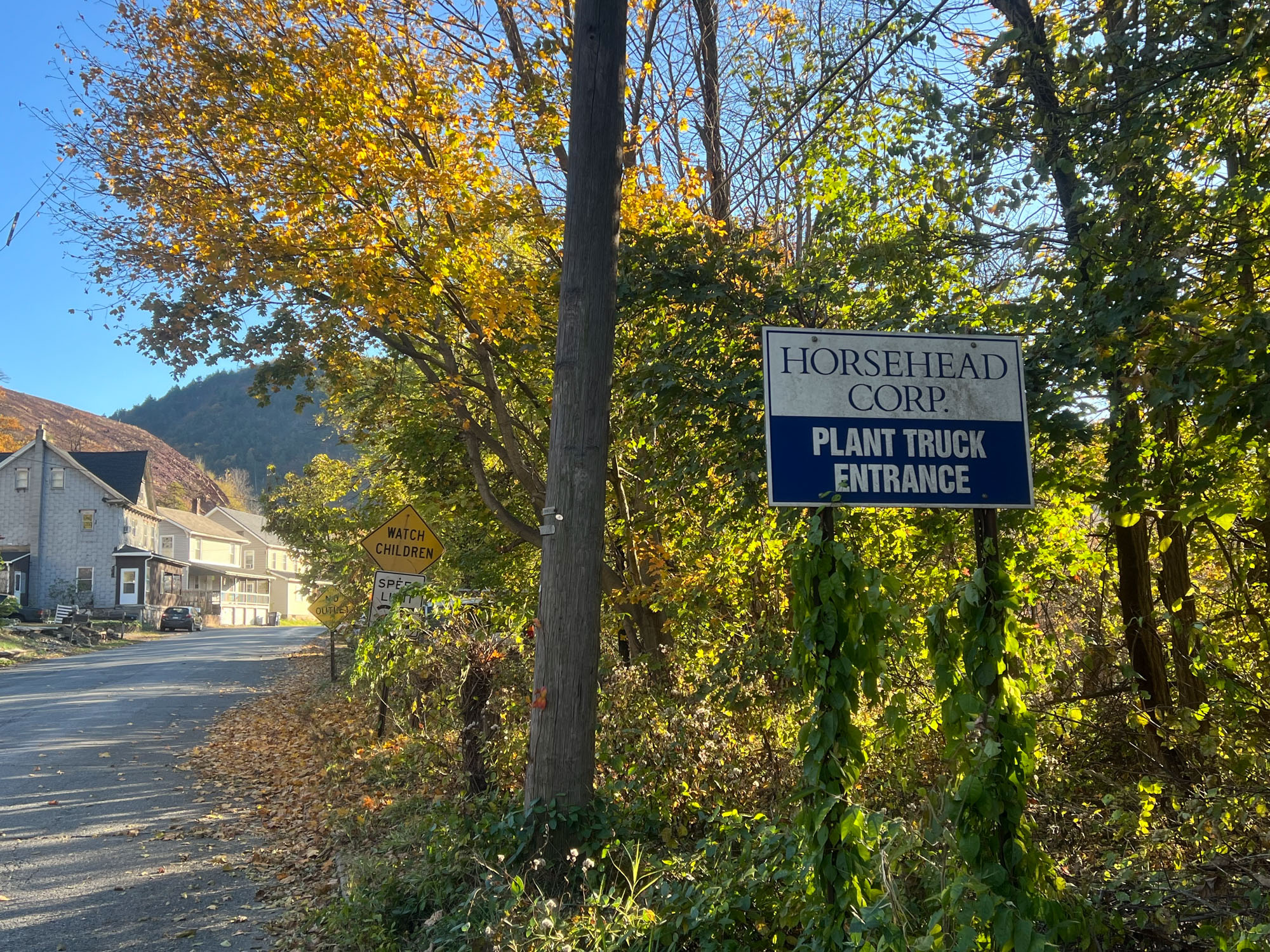PALMERTON, Pennsylvania — When this Lehigh Valley town’s prized zinc smelting factory closed in 1981, it left behind 3,000 acres of mountainous land so contaminated with heavy metals that nothing could grow.
EPA prioritized the area for cleanup under the newly enacted Superfund law with hopes of containing the pollution. With the land devoid of vegetation, millions of tons of contaminated soil was at risk of spreading into rivers, creeks and the drinking water supply in Palmerton, a town of 5,600 people.
So a novel plan was devised. With EPA’s blessing, the zinc company spread municipal sewage sludge as fertilizer on the barren land in the 1990s. A sewage sludge mixture was used again in the early 2000s, with a total of 112,515 wet tons of the stuff applied as fertilizer.
 Aquashicola Creek runs next to the Superfund site in Palmerton, Pennsylvania, eventually merging with the Lehigh River. | Miranda Willson/POLITICO’s E&E News
Aquashicola Creek runs next to the Superfund site in Palmerton, Pennsylvania, eventually merging with the Lehigh River. | Miranda Willson/POLITICO’s E&E News
The effort brought back grasses and trees and helped contain the heavy metals. But Palmerton’s drinking water is now contaminated by different pollutants: “forever chemicals” — per- and polyfluoroalkyl substances, or PFAS. The surface water and soil where sludge was used are also contaminated.
Notorious for their longevity in the environment and in the human body, PFAS are linked to health issues such as fertility problems, high blood pressure and cancer. Amid growing evidence that sewage sludge can contain and spread the chemicals, some locals suspect that the pollution remedy for the Superfund site unknowingly created a PFAS hot spot.
“An awful lot of sewage sludge was put there, and now there’s PFAS contamination in the borough’s wells,” said Dan Kunkle, who founded the nonprofit Lehigh Gap Nature Center in nearby Slatington. “It’s not proof, but it’s a pretty likely source of contamination.”
 Dan and Lee Kunkle with their dog, Luna, stand outside the Lehigh Gap Nature Center. | Miranda Willson/POLITICO’s E&E News
Dan and Lee Kunkle with their dog, Luna, stand outside the Lehigh Gap Nature Center. | Miranda Willson/POLITICO’s E&E News
The borough of Palmerton water department listed “biosolids used for vegetative growth” as the source in a recent water quality report. Biosolids is the technical term for sewage sludge fertilizer. After investigating the site this summer, EPA has also concluded that either the site itself or the remediation are the likely sources of the chemicals and said it would install a PFAS treatment system for Palmerton.
The announcement came after EPA tested for and detected high levels of PFOA and PFOS in the surface water, groundwater and soil in areas of the zinc Superfund site where sludge was used. Those are considered the most toxic types of PFAS and were phased out of production a decade ago.
“EPA is working with Palmerton Borough, [the water authority], and Pennsylvania Department of Environmental Protection (PADEP) to develop the best strategy to ensure Palmerton community members have long-term access to safe drinking water,” the agency said in a notice to the community this week.
The notion that sewage sludge used during a federal cleanup likely tainted the area with PFAS could amplify calls by environmentalists for stronger sewage sludge regulations and testing for forever chemicals.
It also raises questions about whether other Superfund sites that were cleaned up using sewage sludge fertilizer could be contaminated. It’s not clear exactly how many others were treated that way, but EPA’s most recent Superfund remedy report mentions biosolids as a cleanup option.
“The PFAS compounds are very persistent in the environment,” said Jim Woolford, a retired EPA staffer who led the agency’s Superfund program for over a decade. “This, of course, has other implications for other sites that used biosolids.”
 Blue Mountain was devoid of vegetation for years due to the zinc smelting emissions, as seen in this historical photo. | Lehigh Gap Nature Center
Blue Mountain was devoid of vegetation for years due to the zinc smelting emissions, as seen in this historical photo. | Lehigh Gap Nature Center
First manufactured in the 1940s, PFAS are a family of chemicals used in consumer products and firefighting foam because of their resistance to heat, water and oil. Even small amounts of the substances are considered harmful to human health.
The chemicals today are found in almost half of the nation’s drinking water. They’ve also been detected in wastewater and in sewage sludge, which is the semisolid, nutrient-rich material left over after wastewater is treated.
The situation in Palmerton underscores a bleak reality. As more towns have started testing for PFAS, tens of millions of Americans are learning that their drinking water is contaminated. Sewage sludge is increasingly being eyed as a suspected source in rural areas where it is used as fertilizer, most often on farmland but also on degraded or contaminated lands.
EPA has long promoted the use of sewage sludge fertilizer. Wastewater treatment plants produce huge amounts of the material, which must be sent to landfills or incinerated if it isn’t reused. But the agency has not set regulatory limits for PFAS in sewage sludge.
“One of the things the agency needs to do is set those limits,” Woolford said.
The Biden administration began to investigate the risk of PFAS in sewage sludge, releasing a draft report in January that warned that the material can contain forever chemicals. The Trump administration has not committed to finalizing the report or pursuing regulations.
Asked about the agency’s plans for addressing the risk of PFAS in sewage sludge, agency spokesperson Carolyn Holran said the Biden administration report had caused “a lot of confusion” among the public. She noted that the Trump administration extended the public comment period for the report.
“The comment period closed in August and the agency is in the process of reviewing comments and charting a path forward that will protect public health where appropriate while supporting wastewater treatment plants and beneficial use of biosolids,” Holran said in an email.
A dying mountain
Palmerton is located 18 miles northwest of Allentown in Pennsylvania’s historic coal country. It was founded in 1898 as a company town for zinc smelting plants, the first of which opened that year.
 Downtown Palmerton today is located less than a mile from the Superfund site. | Miranda Willson/POLITICO’s E&E News
Downtown Palmerton today is located less than a mile from the Superfund site. | Miranda Willson/POLITICO’s E&E News
The town today sits along the Appalachian Trail and boasts a quaint downtown less than a mile away from the Palmerton Zinc Pile Superfund site. Its drinking water comes from wells located about 300 feet below the base of Blue Mountain, a prominent portion of the site.
When EPA prioritized the land for federal cleanup in 1983, it was loaded with cadmium, lead, zinc, arsenic, manganese and other cancer-causing pollutants that spread through air emissions from zinc smelters. The metals were deposited along Blue Mountain, including on some National Park Service land, and blanketed hundreds of private homes and lawns, killing even the grass.
“I can remember going up there and picking up blueberries in the ‘50s,” said Sarina Berlow, a Palmerton resident who grew up in the area. “Then the mountain began to die.”
 This historical photo of Blue Mountain shows the area devoid of vegetation. | Lehigh Gap Nature Center
This historical photo of Blue Mountain shows the area devoid of vegetation. | Lehigh Gap Nature Center
Cleanup proved complex, owing to the large size of the site and the steep slopes of Blue Mountain, according to EPA documents and archived articles from The Morning Call newspaper. An early idea was to “scoop out up to 2.7 million cubic yards of contaminated soil, a process that would cost $483 million,” the Allentown-based paper reported in 1987.
The company responsible for cleanup at that time, Horsehead Industries, proposed an alternative: applying a mix of sewage sludge, fly ash and limestone to fertilize and revegetate the land. Lime was selected to counter the acidic metals, so they would not dissolve and migrate into the groundwater and surface waters like the Lehigh River, said Kunkle, the founder of the Lehigh Gap Nature Center.
“They thought this would be not just a way to remediate their land, but a commercial venture that would be profitable in the long run,” said Kunkle, a retired high school teacher who lived in the area while cleanup was occurring. “That’s why they named [the mixture] Ecoloam. They were going to try to market it, I believe.”
Horsehead filed for bankruptcy in 2016. Following various mergers and acquisitions, CBS, part of Paramount, is now responsible for remaining cleanup costs. Paramount declined to comment.
 American Zinc Recycling, formerly known as Horsehead, operates a metals recycling facility on the Superfund site. | Miranda Willson/POLITICO’s E&E News
American Zinc Recycling, formerly known as Horsehead, operates a metals recycling facility on the Superfund site. | Miranda Willson/POLITICO’s E&E News
EPA was open to using sewage sludge fertilizer. In 1987, the agency stated that Horsehead had tested its sewage sludge mixture and that it was effective at promoting plant growth and preventing metals from spreading.
It was also cheaper than other cleanup methods, because nearby cities that supplied the sewage sludge were eager to get rid of the material.
“The cost to implement the alternative would be minimal,” EPA stated in a 1987 report.
Sewage sludge is treated to remove pathogens and pollutants like heavy metals and polychlorinated biphenyls. But EPA staff overseeing the cleanup would not have known of the risks of PFAS at the time. 3M, a major chemical manufacturer, first warned the agency that sewage sludge could contain high concentrations of PFAS in 2003, according to reporting by The New York Times.
“Although PFAS were already being used, the ability to analyze them and test for them back then was not established yet,” said Faith Kibuye, a water resources extension specialist at the Pennsylvania State University.
The sludge applied came from at least 16 different wastewater treatment plants in Allentown; New York City; Rahway, New Jersey; Warminster, Pennsylvania; and other communities, according to a list provided by EPA.
Warminster is home to a former Navy training center, which for decades used a firefighting foam made of PFAS. The former training center is now a PFAS-laden Superfund site, with extremely high concentrations of PFOS reported in the groundwater.
There were two rounds of sewage sludge application on the Palmerton Superfund site. The first occurred between 1991 and 1996 and spanned 763 acres, with 105 wet tons of sewage sludge applied per acre. The second round was between 2000 and 2002 and covered another 120 acres, at a rate of 270 wet tons of sludge per acre, according to figures provided by EPA.
The amount of sludge used was more than is typical for fertilizing farmland, said Laura Orlando, a senior scientist at the environmental nonprofit Just Zero who reviewed the numbers. The Massachusetts-based organization has advocated against land applying sewage sludge that contains PFAS.
“Two-hundred-and-seventy wet tons is more than twice the ‘upper bound,’” Orlando said, using EPA’s sewage sludge risk assessment as a reference point. “It does definitely point to the Superfund site as a potential [PFAS] source.”
EPA declined to make a staffer available to discuss the remediation, but answered questions over email.
In 2002, the agency stopped using sewage sludge in Palmerton due to a “negative public perception” and switched to compost, according to a 2018 report.
An alarming discovery
The PFAS discovery in Palmerton last year comes as the original contamination threat — heavy metals — has subsided.
In a major cleanup milestone, EPA announced in 2021 that it had finished remediating 117 private properties near the former zinc factory where soil and indoor air had been contaminated with lead, a potent neurotoxin. The properties were removed from the Superfund site’s boundaries.
Metals are still present in high concentrations elsewhere on the site, including in a 2.5-mile-long waste pile, known as a cinder bank, which is visible from town. But much of Blue Mountain blends in with the rolling hills of the Lehigh Valley, lined with trees in shades of orange and red on a recent fall day. In addition, a portion of the mountain has been turned into the Lehigh Gap Nature Center, the only such center located on a Superfund site.
The nature center purchased several hundred acres of the 3,000-acre Superfund site in the early 2000s and has successfully grown native prairie grasses and trees. Hundreds of animal, plant and fungus species have been documented on the land there.
“Things are going well,” said Chad Schwartz, executive director of the nature center. “For that reason, I think the restoration will soon be moving into a different phase, where there’s less active management.”
 The Lehigh Gap Nature Center is located on the Superfund site in Slatington, Pennsylvania. | Miranda Willson/POLITICO’s E&E News
The Lehigh Gap Nature Center is located on the Superfund site in Slatington, Pennsylvania. | Miranda Willson/POLITICO’s E&E News
The portion of the Superfund site housing the nature center is located in Slatington, across the Lehigh River from Palmerton. Unlike the rest of the site, the land there was originally remediated with fertilizer, crushed limestone and mushroom-based compost — not sewage sludge.
Kunkle, the center’s founder, said he was against using sludge on the nature center land, due to concerns that it could contain more heavy metals. Sludge was also found to be less effective as a fertilizer compared to compost from nearby mushroom farms, he said.
“My statement at the time was, ‘This site has enough trouble, why bring in something that could contaminate it potentially more?’” Kunkle said.
Schwartz said the nature center’s groundwater has not been tested for PFAS. But the municipal drinking water in Slatington has not detected the chemicals, according to EPA data. Other than Palmerton, no communities in Carbon County have PFAS levels that exceed Pennsylvania drinking water standards, according to the state’s Department of Environmental Protection.
“DEP and EPA have not made any determination about the source of PFAS in Palmerton’s water; however, potential sources are being investigated,” DEP spokesperson Neil Shader said in an email.
Palmerton’s local government and water department did not respond to interview requests. PFAS levels in the town’s water have fluctuated since the contamination was identified last year, with 49.3 parts per trillion of PFOS and 34.5 ppt of PFOA being the highest concentrations reported.
That’s far higher than the maximum levels EPA established in its national PFAS drinking water regulation last year, which are 4 ppt for PFOS and for PFOA.
The contamination on the Superfund site itself is higher. The maximum level of PFOS detected in the surface water there is 110 ppt, while the maximum level in the soil was 13,000 ppt, EPA said. The Centers for Disease Control and Prevention considers PFOS levels in soil above 52 ppt to be potentially unsafe to adults.
EPA said it expects to install a groundwater treatment system for Palmerton’s drinking water wells by mid-2026, using funds available through the Superfund program. Due to the difficulty of removing PFAS from water, such treatment systems can cost millions of dollars.
“EPA will continue investigating site-related PFAS contamination to determine any additional sources of PFAS and the extent of the impacts, which will include testing private drinking water wells for PFAS, throughout the rest of 2025 and into 2026,” the agency said in its community notice.
 A 2.5-mile-long heavy metal waste pile, known as a cinder bank, is visible in Palmerton and is a major part of the Superfund site. | Miranda Willson/POLITICO’s E&E News
A 2.5-mile-long heavy metal waste pile, known as a cinder bank, is visible in Palmerton and is a major part of the Superfund site. | Miranda Willson/POLITICO’s E&E News
Woolford said the levels of PFAS found on the Superfund site should prompt EPA to investigate whether other contaminated lands treated with sewage sludge might have a similar problem.
“I would bet dollars to donuts that they are doing that internally,” he said in an email. “Given that the Superfund remedial decision documents (records of decision/RODS) have been digitized, EPA HQ (or its contractors) can do a search to winnow down potential sites where bio-remediation was part of a remedy.”
Berlow, the Palmerton resident, said the PFAS discovery has been alarming. She uses a water filtration system at home, but she worries about her neighbors, including children, drinking the tap water.
“Those of who live here are very proud of this community. The damage that was done, I believe, was done inadvertently,” Berlow said. “The mountain is green now … [but] we’re still at risk, in many ways.”

